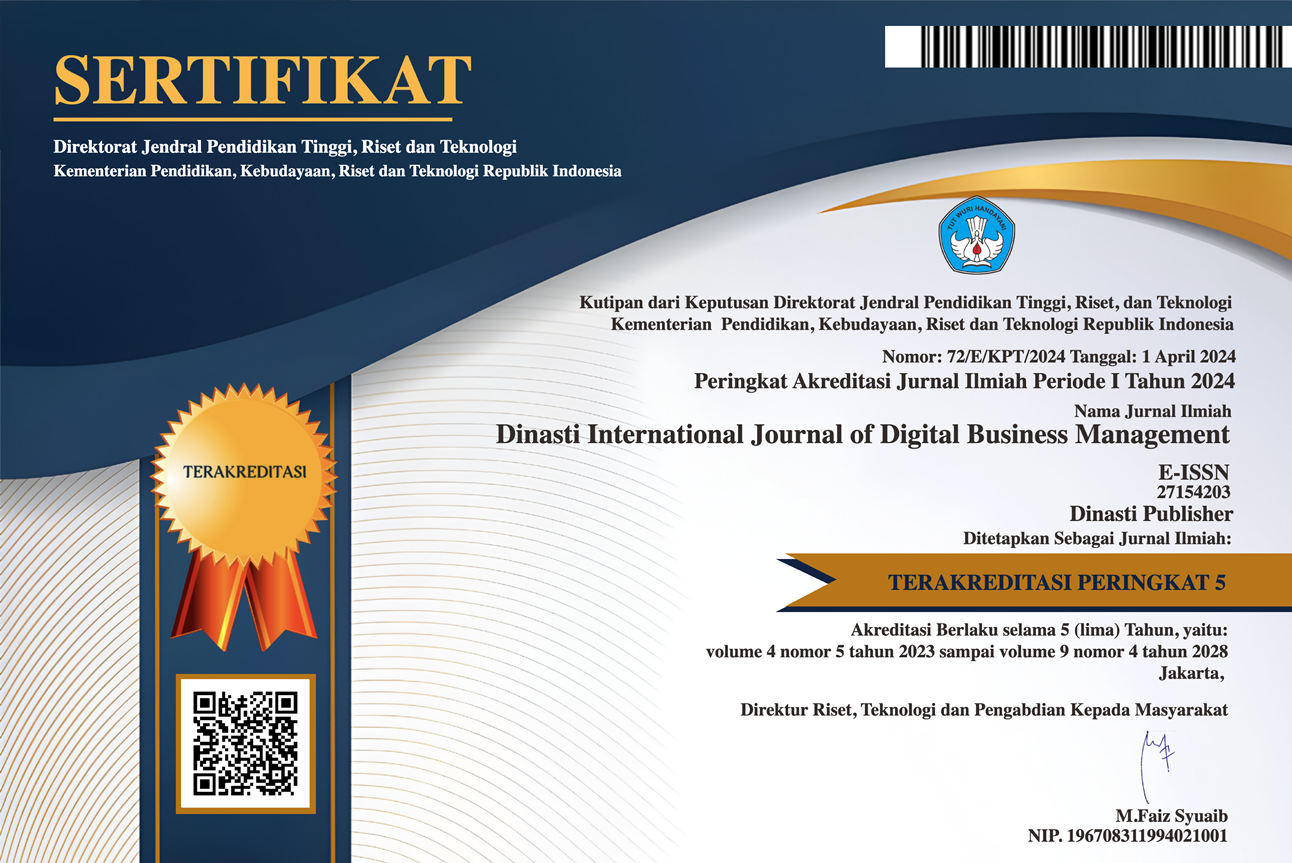Eco-Friendly Product Purchase Behavior Model: Application of Theory of Planned Behavior in Generation Z Consumers
DOI:
https://doi.org/10.38035/dijdbm.v5i5.3035Keywords:
Eco-Friendly, Generation Z, Consumers, Purchase Behavior, TPBAbstract
The use of environmentally friendly (eco-friendly) products is the best solution for maintaining environmental sustainability. The consumption behavior of Generation Z can be a starting point that has an important role if these young buyers actively contribute to promoting sustainable economic development and purchasing eco-friendly products. This study aimed to analyze (1) the relationship between consumer attitudes, subjective norms, and perceived controls with the purchase intention of eco-friendly products in generation Z consumers, and (2) the relationship between the purchase intention of eco-friendly products and eco-friendly product purchase behavior in generation Z consumers. The approach used was explanatory research with a quantitative analysis research method. The study population was Generation Z consumers in Jambi with a sample of 200 respondents. Non-probability sampling technique was used to select research samples. The instrument used was a research questionnaire. The data were analyzed using the Structural Equation Model (SEM/PLS) with the smartPLS analysis tool. The results showed that consumer attitudes have a significant effect on the purchase intention of eco-friendly products in Generation Z consumers. Whereas, subjective norms have no effect on the purchase intention of eco-friendly products in Generation Z consumers. Furthermore, there is a positive effect between behavioral controls and the purchase intention of eco-friendly products in Generation Z consumers. The purchase intention of Generation Z consumers has an effect on eco-friendly product purchase behavior. The results of this study are expected to be implemented in order to maintain environmental sustainability and a green economy as well as to contribute and become reference literature for academics, universities, local governments, consumers, and business actors.
References
Ajzen, I. (1991), “The theory of planned behavior”, Organizational Behavior and Human Decision Processes, Vol. 50 No. 2, pp. 179-211
Abrar, M., Sibtain, M. M., & Shabbir, R. (2021). Understanding purchase intention towards eco-friendly clothing for generation Y & Z. Cogent Business and Management, 8(1). https://doi.org/10.1080/23311975.2021.1997247
Al-Gasawneh, J. A., & Al-Adamat, A. M. (2020). The mediating role of e-word of mouth on the relationship between content marketing and green purchase intention. Management Science Letters, 10(8), 1701–1708. https://doi.org/10.5267/j.msl.2020.1.010
Alamsyah, D. P., Othman, N. A., Bakri, M. H., Udjaja, Y., & Aryanto, R. (2021). Green awareness through environmental knowledge and perceived quality. Management Science Letters, 11, 271–280. https://doi.org/10.5267/j.msl.2020.8.006
Alamsyah, D. P., Syarifuddin, D., & Mohammed, H. A. A. (2018). Green Customer Behavior on Eco-Friendly Products: Innovation Approach. Jurnal Dinamika Manajemen, 9(2), 159–169. https://doi.org/10.15294/jdm.v9i2.15386
Alty Amalia, F., Sosianika, A., & Amanda Christabel, F. (2021). Green Purchase Intention of Indonesian Young Consumers: Extending VAB Framework. Journal of Marketing Innovation, 1, 1–17. http://doi.org/10.35313/jmi.v1i01.9
Chandra, W., Rahbar, E., & Wahid, N. A. (n.d.). Investigation of green marketing tools ’ effect on consumers ’ purchase behavior Investigation of green marketing tools ’ effect on consumers ’ purchase behavior. https://doi.org/10.1108/17515631111114877
Haque, A., Nayeem, A. R., Hossain, M. N., Abdullah, F., & Fatema Akter, M. (2020). Factors affecting on consumer’s purchase intention towards eco-friendly products in Malaysia. Issues in Business Management and Economics, 8(4), 72–83. https://doi.org/10.15739/IBME.20.007
Iacobucci, D. (2010). Structural equations modeling: Fit Indices, sample size, and advanced topics. Journal of Consumer Psychology, 20(1), 90–98. https://doi.org/10.1016/j.jcps.2009.09.003
Jaiswal, D., & Kant, R. (2018). Green purchasing behaviour: A conceptual framework and empirical investigation of Indian consumers. Journal of Retailing and Consumer Services, 41(November 2017), 60–69. https://doi.org/10.1016/j.jretconser.2017.11.008
Johannes, J., Octavia, A., & Suwarti, Y. (2017). the Effect of Hedonic Lifestyle, Hedonic
Motivation and Quality of Products To Interest Recycling Tupperware Product in Jambi Cty. Journal of Business Studies and Mangement Review, 1(1), 18–25. https://doi.org/10.22437/jb.v1i1.3918
Kautish, P., & Sharma, R. (2019). Value orientation, green attitude and green behavioral intentions: an empirical investigation among young consumers. Young Consumers, 20(4), 338–358. https://doi.org/10.1108/YC-11-2018-0881
Lai, C. K. M., & Cheng, E. W. L. (2016). Green purchase behavior of undergraduate students in Hong Kong. The Social Science Journal, 53(1), 67–76. https://doi.org/10.1016/j.soscij.2015.11.003
Lin, S. T., & Niu, H. J. (2018). Green consumption?: Environmental knowledge , environmental consciousness , social norms , and purchasing behavior. November 2017, 1–10. https://doi.org/10.1002/bse.2233
Miller, Z. D. (2017). The Enduring Use of the Theory of Planned Behavior. Human Dimensions of Wildlife, 22(6), 583–590. https://doi.org/10.1080/10871209.2017.1347967
Mohiuddin, M., Al Mamun, A., Syed, F. A., Masud, M. M., & Su, Z. (2018). Environmental knowledge, awareness, and business school students’ intentions to purchase green vehicles in emerging countries. Sustainability (Switzerland), 10(5). https://doi.org/10.3390/su10051534
Octavia, A., Hasbullah, H., & Sriayudha, Y. (2020). Development Model of Social Media Marketing – Consumer Loyalty Mediated By Brand Equity and Consumer Response To Fashion Branded Products. Dinasti International Journal of Digital Business Management, 2(1), 20–29. https://doi.org/10.31933/dijdbm.v2i1.633
Octavia, A., & Sriayudha, Y. (2018). the Decision of Visiting and Tourists Behaviour. Journal of Business Studies and Management Review (JBSMR), 1(2), 66–71.
Ogiemwonyi, O., Harun, A. Bin, Alam, M. N., Karim, A. M., Tabash, M. I., Hossain, M. I., Aziz, S., Abbasi, B. A., & Ojuolape, M. A. (2020). Green product as a means of expressing green behaviour: A cross-cultural empirical evidence from Malaysia and Nigeria. Environmental Technology and Innovation, 20, 101055. https://doi.org/10.1016/j.eti.2020.101055
Rausch, T. M., & Kopplin, C. S. (2021). Bridge the gap: Consumers’ purchase intention and behavior regarding sustainable clothing. Journal of Cleaner Production, 278, 123882. https://doi.org/10.1016/j.jclepro.2020.123882
Roza, S., Sriayudha, Y., Khalik, I., Octavia, A., Economic, F., Jambi, U., Economic, F., Jambi, U., Economic, F., Jambi, U., Economic, F., & Jambi, U. (2022). CONSUMER ATTITUDE TOWARDS ADVERTISING ON INSTAGRAM?: THE ROLE OF ADS PERSONALIZATION AND. 3(1), 130–140.
Saleem, M. A., Khan, M. A., & Alam, S. (2015). Antecedents Of Green Purchase Intentions: Evidence From Customers Of Electronics Products from Multan District. European Academic Research, II(11), 14900–14916.
Shukla, S. (2019). A Study on Millennial Purchase Intention of Green Products in India: Applying Extended Theory of Planned Behavior Model. Journal of Asia-Pacific Business, 20(4), 322–350. https://doi.org/10.1080/10599231.2019.1684171
Siddique, M. Z. R., Saha, G., & Kasem, A. R. (2021). Estimating green purchase behavior: an empirical study using integrated behavior model in Bangladesh. Journal of Asia Business Studies, 15(2), 319–344. https://doi.org/10.1108/JABS-04-2019-0120
Sriayudha, Y., & Nifita, A. T. (2014). Analysis of Preferences and Consumer Behavior of Batik Jambi. 28–34.
Wu, S.-I., & Chen, Y.-J. (2014). The Impact of Green Marketing and Perceived Innovation on Purchase Intention for Green Products. International Journal of Marketing Studies, 6(5), 81–100. https://doi.org/10.5539/ijms.v6n5p81
Xu, Z., Shan, J., Li, J., & Zhang, W. (2020). Extending the theory of planned behavior to predict public participation behavior in air pollution control: Beijing, China. Journal of Environmental Planning and Management, 63(4), 669–688. https://doi.org/10.1080/09640568.2019.1603821
Yenipazarli, A., & Vakharia, A. (2015). Pricing, market coverage and capacity: Can green and brown products co-exist? European Journal of Operational Research, 242(1), 304–315. https://doi.org/10.1016/j.ejor.2014.09.039
Zhang, Q., Zhao, Q., & Zhao, X. (2019). Manufacturer’s product choice in the presence of environment-conscious consumers: brown product or green product. International Journal of Production Research, 57(23), 7423–7438. https://doi.org/10.1080/00207543.2019.1624853
Downloads
Published
Issue
Section
License
Copyright (c) 2024 Ade Octavia, Yayuk Sriayudha, Musnaini Musnaini

This work is licensed under a Creative Commons Attribution 4.0 International License.
Authors who publish their manuscripts in this journal agree to the following conditions:
- The copyright on each article belongs to the author(s).
- The author acknowledges that the Dinasti International Journal of Digital Business Management (DIJDBM) has the right to be the first to publish with a Creative Commons Attribution 4.0 International license (Attribution 4.0 International (CC BY 4.0).
- Authors can submit articles separately, arrange for the non-exclusive distribution of manuscripts that have been published in this journal into other versions (e.g., sent to the author's institutional repository, publication into books, etc.), by acknowledging that the manuscript has been published for the first time in the Dinasti International Journal of Digital Business Management (DIJDBM).















































